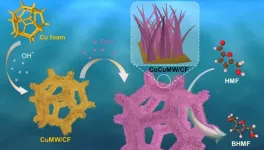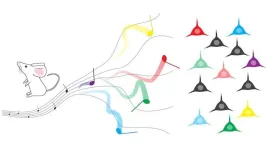###
Please contact media@sfn.org for the full-text PDF.
About eNeuro
eNeuro is an online, open-access journal published by the Society for Neuroscience. Established in 2014, eNeuro publishes a wide variety of content, including research articles, short reports, reviews, commentaries and opinions.
About The Society for Neuroscience
The Society for Neuroscience is the world's largest organization of scientists and physicians devoted to understanding the brain and nervous system. The nonprofit organization, founded in 1969, now has nearly 35,000 members in more than 95 countries.
END
How perception may shape health safety-related assessments
Perceived trustworthiness of others alters activity in different brain networks to drive what may be “safety” and “alarm” signals.
2025-02-10
(Press-News.org) Perceiving whether another person is a personal health risk requires quickly assessing their trustworthiness. With limited characteristics available, implicit assumptions often influence risk perception. Research in this area has pointed to brain regions that may be involved in perceiving others as untrustworthy or as carriers of sexually transmitted diseases (STDs). However, the relationship between brain activity, perceived trustworthiness of others, and perceived likelihood of acquiring an STD was unclear prior to a recent study published in eNeuro. In the study led by Daniela Mier at the University of Konstanz, participants viewed pictures of people and assessed their trustworthiness. The same images had been evaluated in a previous study as having high or low odds of HIV transmission. People in the images with lower perceived odds of HIV transmission were generally considered more trustworthy in the current study by Mier’s group. Brain imaging revealed that perceived low risk of HIV transmission and high trustworthiness both resulted in higher activation of a brain region in the reward network, which may be a “safety signal” in the brain. Conversely, people with higher perceived odds of HIV transmission were more often deemed untrustworthy by participants. But comparisons across groups showed that distrust alone—and not necessarily high likelihood of HIV transmission—led to more activation of brain regions in a different network called the salience network, which may serve as the brain’s “alarm signal.” Ultimately, how humans perceive others seems to alter the activation of reward and salience networks that might play a role in making assessments about the risk others pose to one’s own safety.
ELSE PRESS RELEASES FROM THIS DATE:
Potential new strategy for relieving anxiety
2025-02-10
Understanding the neural circuits that drive anxiety may help researchers discover circuit-specific targets and therefore increase the precision of treatment strategies. Previous studies have separately suggested that increased serotonin levels and the cerebellum may play roles in anxiety. To explore the relationship between these ideas, Pei Chin, from the University of Pennsylvania, and George Augustine, from Temasek Life Sciences Laboratory, probed whether serotonin in the cerebellum causes anxiety behavior in mice. Contrary to previous ...
Scientists develop corrosion-induced electrodes for biomass upgrading
2025-02-10
A research team led by Prof. ZHANG Jian from the Ningbo Institute of Materials Technology and Engineering (NIMTE) of the Chinese Academy of Sciences (CAS) has utilized metal corrosion to prepare high-performance electrodes, enabling efficient and cost-effective upgrading of bio-based 5-hydroxymethylfurfural (HMF). This study was published in Chem Catalysis.
Corrosion is a common phenomenon that can lead to material failure and economic losses. However, researchers are exploring its potential for beneficial applications, particularly in biomass upgrading.
Biomass is among the most abundant renewable resources on earth. Through catalytic conversion, ...
Contemporary hormonal contraception and risk of venous thromboembolism
2025-02-10
About The Study: This study showed venous thromboembolism (VTE) risk variation across hormonal contraceptives with highest rates for combined pills, especially those containing third-generation progestins, and no significant difference in risk for intrauterine devices (IUDs) relative to no use. For patches and implants, the increased VTE risk was uncertain due to limited data. Variation in VTE risk across products underscores the importance of personalized contraceptive counseling.
Corresponding Author: To contact the corresponding author, Harman Gailan Hassan Yonis, MD, email harman@live.dk.
To ...
Victim-shooter relationships in mass shootings involving child victims
2025-02-10
About The Study: The findings of this study indicate that from 2009 through 2020, a child was most likely to be killed in a mass shooting by a parent or family member, rather than a stranger or a peer. While school shootings dominate media coverage, this study suggests that domestic violence plays a larger role in child mass shootings.
Corresponding Author: To contact the corresponding author, Stephanie Chao, MD, email sdchao1@stanford.edu.
To access the embargoed study: Visit our For The Media website at this link https://media.jamanetwork.com/
(doi:10.1001/jamapediatrics.2024.6609)
Editor’s ...
Health care company payouts favor shareholders, new research shows
2025-02-10
It’s widely recognized that health care is a growing expense for many Americans. However, what health care companies do with their profits — some made through government programs such as Medicare — remains murky.
To investigate this question, researchers at Yale School of Medicine (YSM) analyzed financial reports from 92 large U.S. health care companies. The results were published on Feb. 10 in a research letter in JAMA Internal Medicine.
The research team focused on U.S. health care companies on the Standard & Poor’s 500 (S&P 500), which follows the 500 largest companies traded on stock exchanges, to ...
Glucose-lowering medications and risk of COPD exacerbations in patients with type 2 diabetes
2025-02-10
About The Study: The results of this comparative effectiveness research study suggest that sodium-glucose cotransporter-2 inhibitors and glucagon-like peptide-1 receptor agonists (GLP-1RAs) were associated with a reduced risk of moderate or severe chronic obstructive pulmonary disease (COPD) exacerbations compared with dipeptidyl peptidase 4 inhibitors in adults with type 2 diabetes and active COPD. This may inform prescribing of glucose-lowering medications among patients with type 2 diabetes and active COPD.
Corresponding Author: To contact the corresponding author, Elisabetta Patorno, MD, DrPH, email epatorno@bwh.harvard.edu.
To access ...
Low to moderate prenatal alcohol exposure and facial shape of children at ages 6 to 8
2025-02-10
About The Study: Low to moderate prenatal alcohol exposure was associated with characteristic changes in the faces of children, which persisted until at least 6 to 8 years of age. A linear association between alcohol exposure levels and facial shape was not supported.
Corresponding Author: To contact the corresponding author, Evelyne Muggli, MPH, email evi.muggli@mcri.edu.au.
To access the embargoed study: Visit our For The Media website at this link https://media.jamanetwork.com/
(doi:10.1001/jamapediatrics.2024.6151)
Editor’s Note: Please see the article for additional information, including other authors, ...
Earth’s inner core is less solid than previously thought
2025-02-10
The surface of the Earth’s inner core may be changing, as shown by a new study from USC scientists that detected structural changes near the planet’s center, published today in Nature Geoscience.
The changes of the inner core has long been a topic of debate for scientists. However, most research has been focused on assessing rotation. John Vidale, Dean’s Professor of Earth Sciences at the USC Dornsife College of Letters, Arts and Sciences and principal investigator of the study, said the researchers “didn’t set out to define the physical nature of the inner core.”
“What we ended up discovering is evidence that the near surface of Earth’s ...
Discovering the genetics of climate adaptation
2025-02-10
As climate change accelerates, plants face mounting pressure to adapt to shifting ecosystems and environmental conditions. This challenge is especially urgent for crops – plants resilient to drought and heat are essential to secure food supply in an unpredictable future. Fortunately, plants can adapt remarkably well to diverse environments and climates: Arabidopsis thaliana, for example, thrives in regions as climatically distinct as Sweden and Italy.
Understanding how plants naturally adapt to different ...
How does the brain differentiate new stimuli from old ones?
2025-02-10
The cerebral cortex is the largest part of a mammal’s brain, and by some measures the most important. In humans in particular, it’s where most things happen—like perception, thinking, memory storage and decision-making. One current hypothesis suggests that the cortex’s primary role is to predict what’s going to happen in the future by identifying and encoding new information it receives from the outside world and comparing it with what was expected to occur.
A new study published today in the ...
LAST 30 PRESS RELEASES:
Statins significantly reduce mortality risk for adults with diabetes, regardless of cardiovascular risk
Brain immune cells may drive more damage in females than males with Alzheimer’s
Evidence-based recommendations empower clinicians to manage epilepsy in pregnancy
Fungus turns bark beetles’ defenses against them
There are new antivirals being tested for herpesviruses. Scientists now know how they work
CDI scientist, colleagues author review of global burden of fungus Candida auris
How does stroke influence speech comprehension?
B cells transiently unlock their plasticity, risking lymphoma development
Advanced AI dodel predicts spoken language outcomes in deaf children after cochlear implants
Multimodal imaging-based cerebral blood flow prediction model development in simulated microgravity
Accelerated streaming subgraph matching framework is faster, more robust, and scalable
Gestational diabetes rose every year in the US since 2016
OHSU researchers find breast cancer drug boosts leukemia treatment
Fear and medical misinformation regarding risk of progression or recurrence among patients with breast cancer
Glucagonlike peptide-1 receptor agonists and asthma risk in adolescents with obesity
Reviving dormant immunity: Millimeter waves reprogram the immunosuppressive microenvironment to potentiate immunotherapy without obvious side effects
Safety decision-making for autonomous vehicles integrating passenger physiological states by fNIRS
Fires could emit more air pollution than previously estimated
A new way to map how cells choose their fate
Numbers in our sights affect how we perceive space
SIMJ announces global collaborative book project in commemoration of its 75th anniversary
Air pollution exposure and birth weight
Obstructive sleep apnea risk and mental health conditions among older adults
How talking slows eye movements behind the wheel
The Ceramic Society of Japan’s Oxoate Ceramics Research Association launches new international book project
Heart-brain connection: international study reveals the role of the vagus nerve in keeping the heart young
Researchers identify Rb1 as a predictive biomarker for a new therapeutic strategy in some breast cancers
Survey reveals ethical gaps slowing AI adoption in pediatric surgery
Stimulant ADHD medications work differently than thought
AI overestimates how smart people are, according to HSE economists
[Press-News.org] How perception may shape health safety-related assessmentsPerceived trustworthiness of others alters activity in different brain networks to drive what may be “safety” and “alarm” signals.



